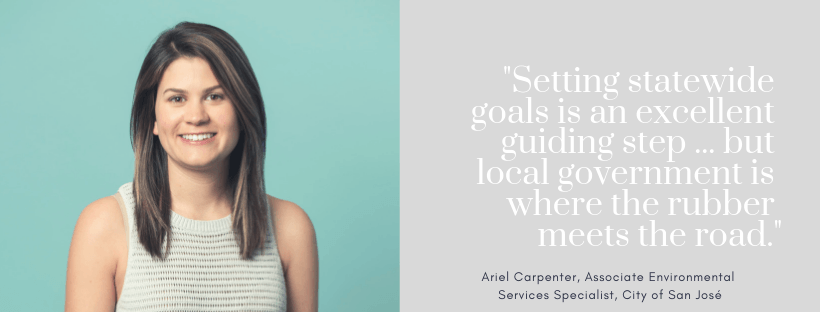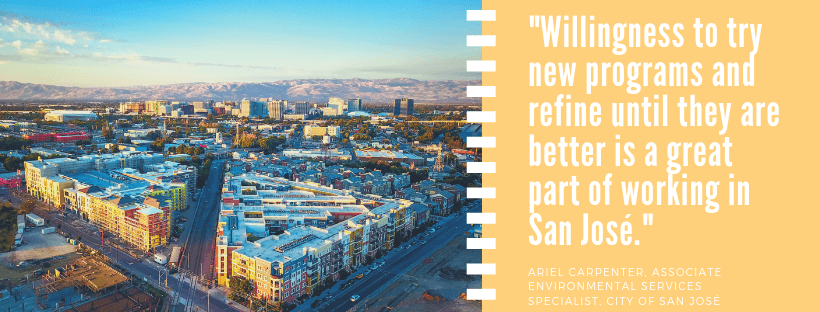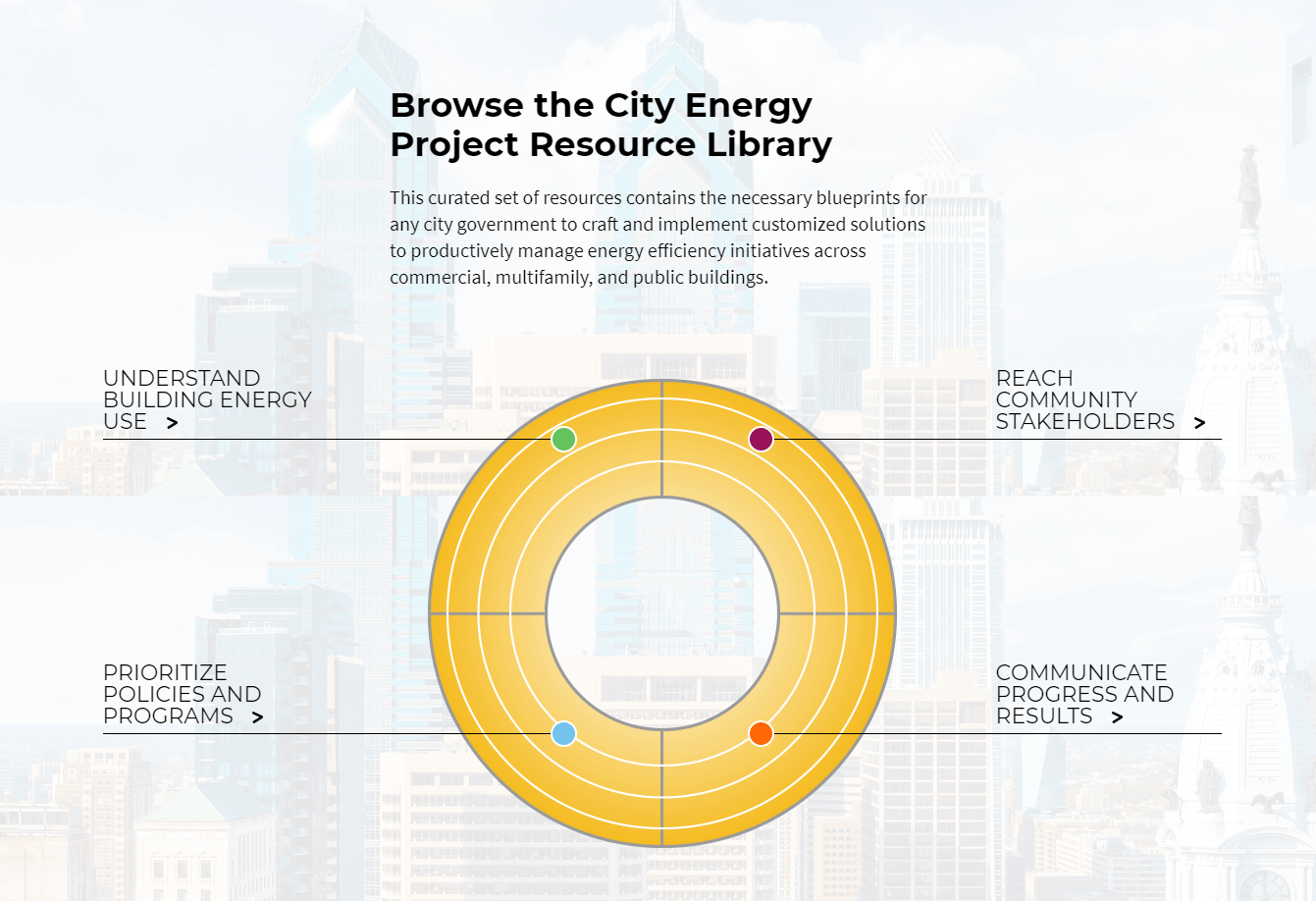What does it take to drive market transformation toward bigger, faster, deeper investments in energy efficiency? To figure this out, the City Energy Project, a national initiative from IMT and the Natural Resources Defense Council, embedded staff in 20 participating cities across the U.S. with a focus on boosting energy efficiency in buildings. These City Advisors help ensure that the energy efficiency efforts pursued by a city are customized to best meet local needs to maximize returns.
Ariel Carpenter is an Associate Environmental Services Specialist at the City of San José, and most recently led the development of San José’s Energy and Water Building Performance Ordinance, which was adopted in late 2018. She holds a degree in environmental science from Boston University. Her experience ranges from climate change research and marine resource management to commercial engagement work as the leader of San José’s contribution to the Step Up and Power Down initiative, a partnership between five California cities and PG&E to reduce energy waste in California’s businesses and homes.

What drew you to efficiency?
I first realized that efficiency work could be a career when I volunteered with Habitat for Humanity during my senior year of high school. It was inspiring to see the positive effects that green building techniques could have on homeowners’ bills and economic positions. I wanted to be a part of that positive work.
My first formal entry into the world of efficiency was working at an efficiency startup as part of a clean tech incubator in Boston, and I’ve remained in the efficiency world ever since.
What excites you most about the City Energy Project?
I am naturally interested in energy efficiency and policy, and I love that this project has visible positive effects on my community. For example, I recently hosted a heat pump water heating training session. When I went down to the permitting department to distribute flyers, the person at the desk told me people were asking about it all the time. It’s those simple reminders that I’m serving the needs of the people of San José that help motivate me.
San José is located within a state that supports climate action and already has a state-mandated benchmarking program. In that context, how does that connect with your city-level work?
The passage of a state-level benchmarking requirement was a great help to us as a foot in the door to talk about this kind of requirement for buildings and how we could improve on the state mandate. Setting statewide goals is an excellent guiding step from the larger government, but local government is where the rubber meets the road. Local initiatives are what help us meet our statewide goals, and benchmarking and transparency are a great starting point for what’s next, like our work with zero net energy buildings and new rebate and incentive programs.
What does your team look like? What does your work look like as a city advisor?
My position is housed in the Environmental Services Department, which includes more than 550 people who work on everything from integrated waste work to stormwater management. Specifically, I am on the Energy Efficiency team within the department’s Sustainability and Compliance Division. Though my focus has been on San José’s benchmarking policy (adopted by the City Council in December 2018), other staff on my team have been leaders on San José’s climate action plan, Climate Smart San José, and our work falls under the City’s goal of greenhouse gas reductions.

What does your day-to-day work look like?
Though my work is primarily devoted to San José’s benchmarking policy, what form that takes changes from one day to the next. My daily activities range from internal and external presentations to stakeholders to political strategy and talking with community members about the benchmarking policy.
What skills have helped you the most in your work?
This position requires a great deal of communication. Passing and implementing an expanded benchmarking and transparency ordinance requires the coordination and support of internal and external stakeholders. I’ve found my technical expertise across multiple STEM disciplines has helped me engage with stakeholders, but my experience navigating complex political landscapes has been even more crucial.
I am not afraid to speak up or have difficult conversations, and I approach problems from the perspective of finding consensus, rather than assigning right or wrong to any topic. When engaging with internal and external stakeholders, it’s important to make sure everyone is working off the same knowledge base, be comfortable having multiple conversations with your contacts about the same issues, and recognize that solutions will not always arrive quickly.
What was the biggest challenge you faced in your work as a City Energy Project City Advisor?
Balancing policy and politics. We recognize that we must remain politically neutral and be sensitive in how we time our work to avoid stakeholder fatigue.
What’s it like working in San José?
In a municipality as large as San José, with so many initiatives occurring at any given time, it can be difficult for one particular program to gain attention. Because of this, city staff are constantly collaborating to ensure that our efforts our aligned, our messages are clear, and our service is seamless.
Regardless of our challenges, we are a municipal government committed to promoting our climate action work, and San José is well-positioned to be a pilot city for environmentally and socially conscious programs elsewhere. The city recognizes the importance of making data-based decisions involving broad community engagement. San José also has a lot in common with other large American cities in terms of our historically suburban development patterns, pragmatic approach, and political climate. Of course, we don’t always get everything perfect the first time, but that willingness to try new programs and refine them until they are better is a great part of working in San José.

The City Energy Project is a national initiative to create healthier, more prosperous American cities by improving the energy efficiency of buildings. The pioneering actions taken by the 20 participating cities are now distilled in a cured yet comprehensive City Energy Project Resource Library, a must-use tool for any jurisdiction on how to leverage energy efficiency to reach ambitious climate, economic, and social goals. Learn more at cityenergyproject.org.
